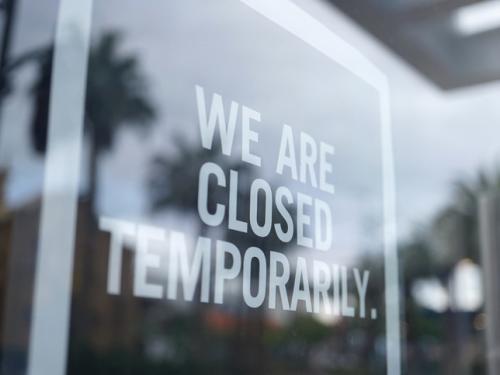A global pandemic, social injustices across the nation, the war in Ukraine, economic volatility, and a surge in layoffs all factor into the increase in mental stress affecting employees. Just ask a counselor or therapist about the flood of new patients they’ve seen in the past two years and the waiting lists for care.
McKinsey research shared in 2021 revealed that nearly half of employees feel symptoms of burnout, and that number is likely an underestimate.
Health care workers especially have experienced a spike in mental health issues. The compounded rates of depression and anxiety among heath care workers have prompted the government to provide $103 million in funds to reduce burnout and promote mental health and wellness among the health care workforce.
Michael Fogas, a staff support liaison at Children’s Healthcare of Atlanta has observed this firsthand within the hospital system. His work focuses on developing resiliency among the staff.
Mental health challenges exist for everyone, but he says that things that surface those challenges or cause them to be more pronounced include common experiences of personal loss — such as a death or the loss of a marriage, job, or physical health issues. Parenting is also getting harder, and the issues are more complicated.
“When you feel powerless, stuck, financially overburdened, or when your kids are sick, all those things trigger a more significant response,” he explains. “When people feel alone in their struggles, the way they cope is to try and control circumstances.”
According to workplace happiness expert and consultant and best-selling author Jenn Lim a sense of control is instrumental for someone to live a sustainably happy life.
inventory your life stress inventory
“As a hospital, we’re uniquely positioned to help staff because we have an infrastructure focused on caregiving,” notes Michael. “As a consequence of that, when people have needs, we seek to address those. We're thinking about caring for people all the time where your typical tech company isn’t necessarily thinking this way.”
If mental health is not on the radar of leaders at your company, it should be. In addition to looking to healthcare models for insights, the military also has a strong infrastructure around mental health support because of the trauma that soldiers experience in their work.
Curious about your stress level? Take the Holmes-Rahe Stress Inventory
Mental Health and the Workplace
“I think a generalized sense of isolation has led people to be less civil,” Michael says. “And the struggle with civility turns to violence.”
Our society indeed sees that violence and many social injustices. And employees are not okay.
A digital mental health solution provider noted in their the Role of Mental Health in DEI report that “Employees from diverse backgrounds or belonging to marginalized groups often deal with microaggressions, unconscious bias, a lack of representation, and other stressors—all of which play a role in their overall mental health and wellbeing.”
It used to be that people found care within community structures, but with that sense of isolation and the new normal of integrating of our personal and work lives, employees are looking to their employers to provide meaningful mental health support to deal with these stresses.
If you’re having conversations about diversity, equity, and inclusion (DEI) programs, mental health is an important element to discuss. According to Forbes, “Given the impact [of mental health] on employees and communities, every employer should see accessible, inclusive mental health as both an ethical imperative and a new strategic priority.”
How you care for your people’s wellbeing can impact whether they stay or go.
Support Mental Health for Employee Retention
According to PwC’s Global Workforce Hopes and Fears Survey 2022 “Employees cited the support they receive on well-being as the third-most-likely way in which companies can address skills and labour shortages.” However “only 29% of respondents said they received this support. Given the scope of the mental-health challenges that workers face, this finding suggests that companies could be doing much more to support worker well-being.”
According to the 2022 State of Workforce Mental Health Report by global workforce mental health partner Lyra, “robust and comprehensive” mental health benefits are a key factor for people when considering a new job, and 59% would stay with a company because it offers these benefits.
In a health study, they found that high-quality mental health care boosts employee retention. The three pillars that contribute to high-quality mental health care are:
- A commitment to evidence-based treatments
- Quality measurement via clinical outcomes
- Peer-reviewed research validation
And when forecasting workforce mental health trends, Lyra has predicted
- Employer-provided mental health support will continue to rise to meet soaring demand
- Flexible work policies that benefit mental health will become a mainstay
- More attention to the mental health needs of kids and families
- A greater focus on destigmatizing serious or complex mental health conditions
- More mental health literacy and education
- A shift toward building workplace structures that prevent burnout
Employees who feel cared for trust their companies and often feel a sense of pride — and possibly even privilege — in working for them. Those who don’t begin looking for an eject button.
The 2022 Retention Report by Work Institute reported that “more than 47 million employees quit their job voluntarily 2021 – the most since the Bureau of Labor Statistics began tracking this statistic in 2001.” This number is up 13% than the previous record high which was in 2019.
The report also notes that the average cost of turnover is approximately $15,000. Gallup, however, states that the cost of replacing an individual employee can range from one-half to two times the employee's annual salary.
Inevitably some different factors are accounted for in each of those turnover stats, but the bottom line is that turnover affects your company’s bottom line—and more. Gallup notes “Losing your best people means losing your reliable winners, your constant innovators, and your most effective problem solvers. Internally, it breaks down team morale.”
Looking for some inspiration on how to innovate in this area? Read about the specific mental health benefit offerings at seven companies as well as 15 Companies That Prioritize the Mental Health of Their Employees.
But remember, it is more than initiatives. Harvard Business Review states “Employees need and expect sustainable and mentally healthy workplaces, which requires taking on the real work of culture change. It’s not enough to simply offer the latest apps or employ euphemisms like ‘well-being’ or ‘mental fitness.’ Employers must connect what they say to what they actually do.”
And that’s when you have a healthy workplace culture where people feel cared for and supported, your customers reap the benefits of happy and engaged employees. You will too.
Need help with DEI initiatives? Please reach out. We offer training, consulting, and coaching services.




